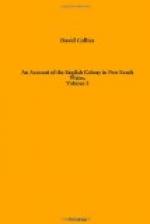The surrounding country was found to be miserable, presenting but very little that was fit even for pasturage, and none good enough for cultivation, except near a shallow lagoon on the west side, on the border of which were seven or eight hundred acres of low ground, of a black mould, rather sandy, which might be cultivated with great advantage. Contiguous to the best part, was a large fresh water swamp, overgrown with reeds and bulrushes.
In the evening of the 21st they entered the mouth of the Derwent.
In passing between two islands, the heads of the seaweed, which, from its size, is named the Gigantic, were showing themselves above the surface in six or eight fathoms water: a diminutive plant when compared with those of the kind seen in higher latitudes, but of vast magnitude in comparison with the generality of seaweeds.
On their various movements in the Derwent, Mr. Bass is silent, confining his narrative to a general account of what he learned and saw of the neighbouring country.
If the Derwent river have any claim to respectability, it is indebted for it more to the paucity of inlets into Van Diemen’s land, than to any intrinsic merits of its own. After a sleepy course of not more than twenty-five or twenty-seven miles to the NW it falls into Frederick Henry Bay. Its breadth there is two miles and a quarter, and its depth ten fathoms. A few hundred yards above its mouth, it is joined, on the west side, by the Storm Bay Passage, and this union makes an island of that slip of land which is Adventure Bay. This island, the Derwent river, and the Storm Bay Passage, were the discovery of Mr. Hayes, of which he made a chart; wherein it was found, by the minute examination of the whole scene which it now underwent, that the smallest runs had been magnified into rivers, and coves into bays and ports. Such glaring errors could not be suffered to exist; but the name, where it was possible, was retained, though the geographical term was necessarily altered.
This dull lifeless stream, the Derwent, is so little affected by the tides, that its navigation is extremely tedious with a foul wind. It takes its way through a country that on the east and north sides it hilly, on the west and north mountainous. The hills to the eastward arise immediately from the banks; but the mountains to the westward have retired to the distance of a few miles from the water, and have left in their front hilly land similar to that on the east side. All the hills are very thinly set with light timber, chiefly short she oaks; but are admirably covered with thick nutritious grass, in general free from brush or patches of shrubs. The soil in which it grows is a black vegetable mould, deep only in the valleys, frequently very shallow, with occasionally a small mixture of sand or small stones. Many large tracts of land appear cultivable both for maize and wheat, but which, as pasture land, would be excellent.




